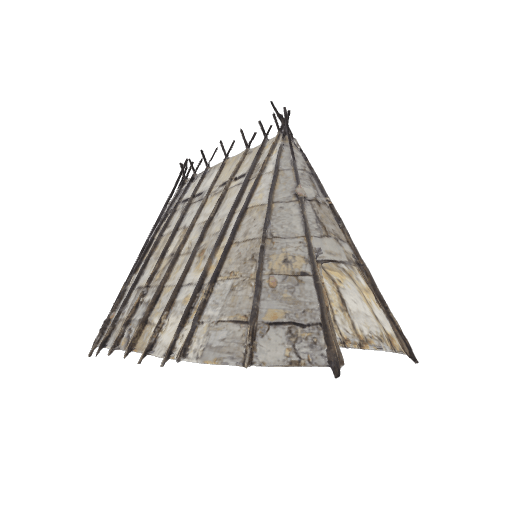Wigwam
Wolastoqiyik: wigwam
Mi’kmaq: wigwom
The wigwam, made of wood and bark, is the habitation of the Algonquian peoples. It is used for resting, socializing, preparing and sharing meals, as well as for spiritual activities.
The size of the wigwam varies, but can most often accommodate more than ten people. Wigwams can be cone-shaped, domed or have a rectangular base. Their construction method differs depending on the Indigenous peoples and their use, which can be temporary or long-term.
To build a wigwam, the first step is to gather the necessary materials: wood and bark. Made from fir or spruce, the wood poles are cut and then tied with roots to form the structure of the dwelling. Large pieces of bark (usually white birch) are placed on the structure in several layers and then sewn together to solidify and ensure waterproofing. The bark is previously treated with water to make it more supple and with heat to increase its impermeability. An opening is kept on one side, protected by an animal hide.
Inside, the floor is covered with branches and furs to keep out moisture and cold and make the habitation more comfortable. A fire is lit in the centre of the wigwam, and possessions are stacked along the walls. The bark can be decorated with different patterns, and when the cold hits, the wigwam can also be covered with animal hides.
During relocation, the birch bark and roots are kept and transported for the construction of the next wigwam. Sometimes, the structure is left behind.
References
Date: After 2000
Origin: Gaspé Bay, public square
Owner: City of Gaspé
Sources:
Prins, H. E. L. (1996). The Mi’kmaq: resistance, accomodation, and cultural survival. Harcourt Brace College Publishers.
Gradacz, R. R. (2008, August 11). Wigwam. In The Canadian Encyclopedia. Retrieved September 15, 2022, from https://www.thecanadianencyclopedia.ca/en/article/wigwam
Laberge, M. (1996). Création d’une nouvelle iconographie sur les algonquiens du Nord-Est de l’Amérique à partir de données ethno-historiques datant d’avant 1760 [The creation of a new iconography of the Algonquians of North-East America using pre-1760 ethno-historical data] [Doctoral dissertation, Université Laval]. CorpusUL. https://corpus.ulaval.ca/bitstreams/ad9a212e-0edb-496f-abf3-1ab25c05f6b3/download
EDUTIC: AKI – Société et territoires autochtones. (n.d.). Construction du wigwam [Building a wigwam]. Université du Québec à Trois-Rivières. Retrieved September 15, 2022, from https://oraprdnt.uqtr.uquebec.ca/pls/public/gscw031?owa_no_site=85&owa_no_fiche=162
